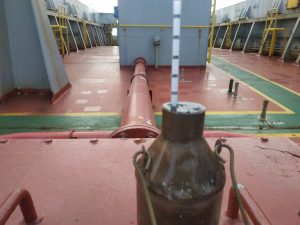Draft survey
A vessel’s draft is the distance from the keel to the waterline.
A draft survey determines the weight of cargo onboard a vessel based on Archimedes’ principle by calculating the changes to displacement.
Draft survey process:
- Checking the vessel’s hydrostatic, trim & stability booklets, sounding tables as well as vessel’s listing angle.
- Reading the ship’s draft marks at all 06 locations at fore, mid, and aft for port and starboard sides.
- Collecting water samples and measuring water density using a calibrated hydrometer.
- Determine deductible weights by sounding all water tanks with sounding tape and collecting oil tank readings.
- Using the provided hydrostatic tables to calculate the ship’s displacement, required corrections, and finally, net displacement after deducting all deductibles including light ship and constant weight.
Tips :
- Ensure the vessel’s list is not more than 0.5° before commencing with a draft survey.
- Double-check sounding pipes for any potential blockages.
- Use a properly calibrated hydrometer (preferably with a calibration certificate for reference).
- Also use a sounding tape in good condition, without twists or chips.
- Ensure all ballasting operations, and loading / discharging operations have completely halted before commencing with a draft survey.
 |
 |









